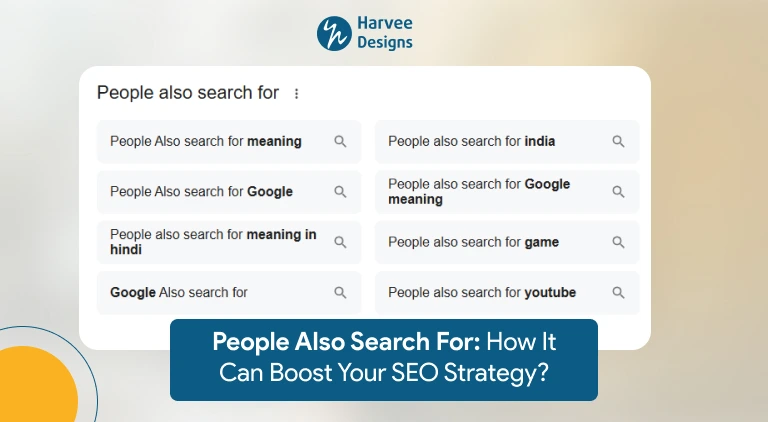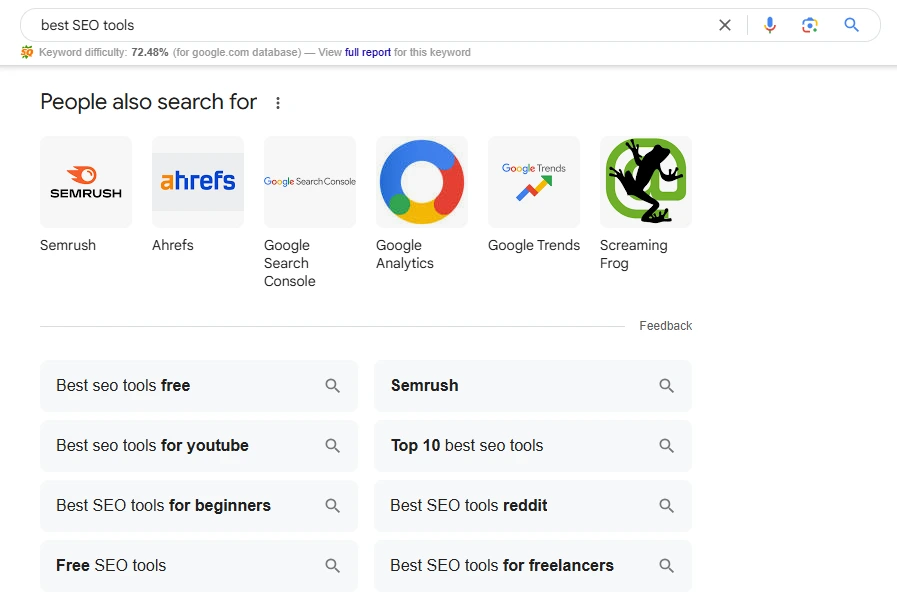
People Also Search For: An Effective Strategy to Increase Your Blog Traffic
We’ve all had times when we searched on Google but couldn’t find the correct answer, no matter how many links we clicked. Then, under the “People Also Search For” section, we see a helpful suggestion that quickly leads us to the correct information. This feature helps us find what we need and shows related topics we might like.
This feature is a key factor in increasing website traffic, as it helps identify and target relevant keywords that can improve search visibility.
This blog will explore how PASF works, why it matters for SEO, and how to use it to attract more visitors. It also discusses how PASF can be helpful for keyword research, content creation, and improving search rankings.
What is “People Also Search For”?
“People Also Search For (PASF)” is a Google feature that suggests related searches based on user behavior. If someone clicks on a result but doesn’t find what they need and returns to Google, PASF appears with alternative keywords to help them find better answers.
Google introduced People Also Search For (PASF) in 2018 to help users find better search results and related keywords.
Here’s how it works: If you click on a search result and then return to Google, the People Also Search For box appears below the link you clicked. It shows keywords that other people have searched for along with your original query, helping you discover more useful topics.
For example, if you search for “best SEO tools” and click on a result, you might see PASF suggestions like
- Best free SEO tools
- Best SEO tools for beginners
- SEO tools for freelancers
- SEO tools for YouTube


How Do PASF Keywords Impact SEO and PPC?
When you type something into Google, you have a reason for it—that’s called search intent. Google’s job is to figure out what you’re looking for and show you the best possible results.
But not everyone searches the same way. Some people already know what they want and type in a business name to find a specific website. Others are still figuring things out and need answers, explanations, or general information.
That’s where People Also Search For (PASF) comes in. If you click on a result and quickly return to Google, PASF suggests other related searches. It’s Google’s way of saying, “Hey, maybe these will help!”—helping you discover things you didn’t even know you needed.
For businesses, this is a great opportunity. By creating content that matches what people are searching for, you’re more likely to show up in their results. And when you give people the answers they need, they’re more likely to trust (and visit) your website.
Why is People Also Search For (PASF) Important for Blog Traffic?
Using PASF in your content strategy can help increase your blog traffic in several ways:
Discovering New Keywords
PASF gives you keyword suggestions that real users are searching for. This means you can create content that directly answers their queries, making your blog more relevant and valuable.
Improving SEO Rankings
When you naturally include PASF keywords in your blog, Google recognizes your content is relevant to multiple related searches. This can improve your ranking for different search terms, increasing visibility.
Matching User Intent
Understanding what users want helps you write content that meets their needs. When your blog provides the correct answers, visitors are more likely to stay longer, reducing bounce rates and improving engagement.
Stay Ahead of the Competition
Many bloggers and website owners focus only on high-volume keywords, ignoring PASF terms. By targeting these suggested queries, you can rank higher for less competitive searches and attract more visitors.
How to Use People Also Search For (PASF) to Increase Blog Traffic
1. Find People Also Search For (PASF) Keywords
To find PASF keywords, follow these steps:
- Search for a topic related to your blog on Google.
- Look at the PASF suggestions that appear below the clicked link.
- Note down the relevant keywords.
You can also use SEO tools like Ahrefs, SEMrush, or Ubersuggest to find PASF keywords quickly.
2. Include People Also Search For (PASF) Keywords in Your Blog
Once you have found PASF keywords, use them naturally in your blog.
- Title & Headings: Add PASF keywords to your blog title and subheadings to make your content more relevant.
- Content: Write in-depth answers for PASF queries so that readers find what they need.
- Meta Description: Use PASF keywords in your meta descriptions to improve click-through rates.
- FAQs Section: Add a section at the end of your blog answering common PASF queries.
3. Create Separate Blogs for People Also Search For (PASF) Keywords
Consider writing a separate blog post if a PASF keyword is broad enough. For example, if you have a blog on “Digital Marketing Trends,” and PASF suggests “Latest Social Media Marketing Trends,” you can write a separate blog post on social media trends and link it to your main blog.
4. Use PASF in Internal Linking
Internal linking is essential for SEO. If you write multiple blogs covering different PASF keywords, link them to each other. This helps search engines understand the connection between your content and keeps visitors on your site longer.
5. Monitor Performance & Update Content
SEO is an ongoing process. Use Google Search Console and analytics tools to track which PASF keywords bring traffic to your blog. Update your content regularly to include new PASF suggestions and stay relevant.
Example: How People Also Search For (PASF) Can Strengthen Your Content Strategy
Consider you’ve written a blog titled “How to Create a Successful Online Store.” After checking PASF, you will find these related searches:
- Best platforms to build an online store
- How to drive traffic to an online store
- Online store marketing strategies
Expand your existing blog by briefly addressing these topics, writing separate, in-depth posts for each PASF query, and interlinking them. Optimize your content and metadata with these keywords to boost search rankings.
How to Get Your Content in People Also Search For (PASF) Recommendations
You need a smart strategy if you want your content to appear in Google’s “People Also Search For” (PASF) suggestions. By understanding what your audience is searching for and creating content that answers their questions, you can increase visibility and attract more visitors.
Understand what your readers need:
Think about why someone is searching for a topic. Are they looking for simple tips, step-by-step guides, or expert advice? Make sure your content matches their needs so they find it helpful.
Write clear and detailed content:
Create well-structured blogs that naturally include PASF-related keywords. For example, if you have an e-commerce website, a post on “how to boost online sales” could consist of PASF-driven sections like “best social media platforms for online stores” or “SEO tips for e-commerce.”
Add schema markup to help Google understand your content:
Structured data (schema markup) helps Google recognize essential details in its content. If you’re working on a website for an IVF clinic, adding schema markup can highlight FAQs, reviews, and expert answers, making it easier to show up in People Also Search For (PASF).
Keep your content fresh and reliable:
Google prefers content from trustworthy sources. If you run a marketing agency, healthcare practice, or online store, regularly update your content with new insights and trends to build trust and authority.
Check competitors and find what’s missing:
Look at who is ranking in PASF for your keywords. What topics do they cover? If they leave out essential details, fill those gaps with better, more detailed, and helpful content.
Importance of People Also Ask For (PASF) in SEO
- PASF suggests related search queries, helping you discover keywords that improve content relevance and rankings.
- Use PASF insights to expand existing content or create new blogs based on trending topics.
- PASF reveals whether users are seeking information, purchasing, or looking for specific websites, allowing you to tailor content accordingly.
- Regularly checking PASF ensures your content stays relevant as search trends evolve.
- PASF often includes specific, low-competition keywords that attract steady traffic.
- Studying PASF queries helps you identify content gaps and create unique, high-value content.
- Optimizing content with PASF keywords increases the chances of appearing in multiple search queries, driving more traffic.
Final Thoughts
“People Also Search For” is more than just a Google feature—a hidden SEO jackpot. Using PASF keywords in your content can help discover new keyword opportunities, improve SEO rankings, match user intent, and stay ahead of the competition.




